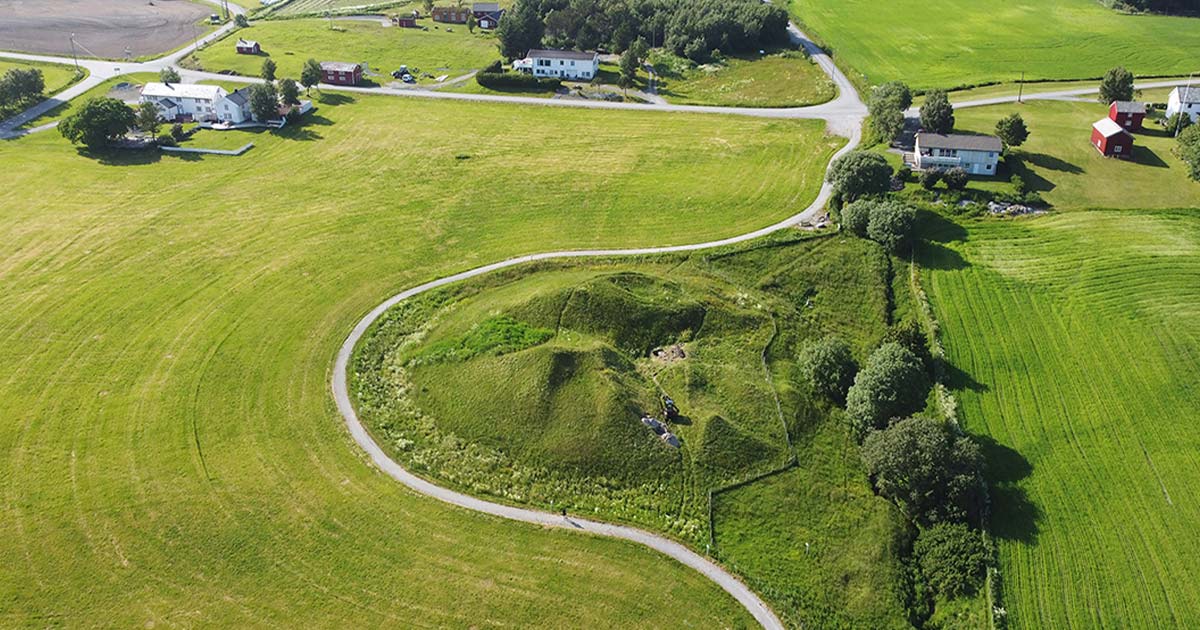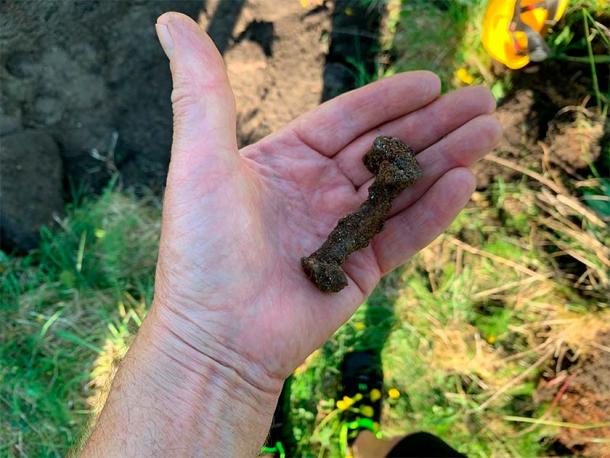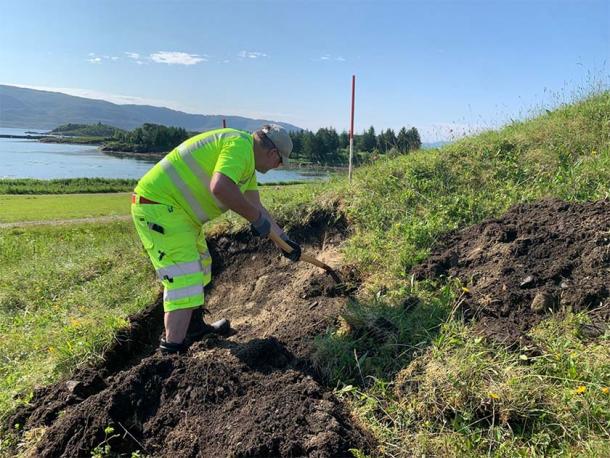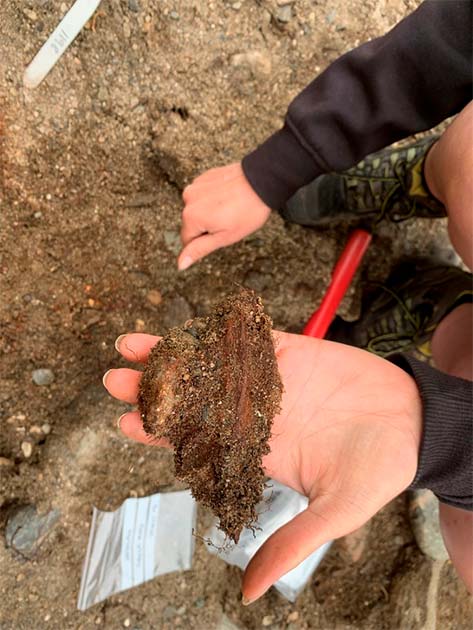The Burial of a 1,300-Year-Old Pre-Viking Ship Rewrites History

The identification of a pre-Viking ship burial unearthed in Norway is helping rewrite history. A previously excavated mound, containing remnants of the oldest large ship ever buried, on the island of Leka in north-central Norway’s Trøndelag county is at the center of this fascinating find.
The seagoing vessel was placed in the ground approximately 1,300 years ago, around the year 700 AD. This is an incredibly important discovery, since it dates to before the beginning of the Viking Age. This pre-Viking ship burial shows the that Vikings weren’t the first ones to bury ships alongside important people, but were only continuing a tradition that had begun in earlier times.

Nails discovered alongside the remains of the pre-Viking ship burial have provided evidence that these kinds of ship burials took place far earlier than previously thought. (Geir Grønnesby / NTNU Science Museum)
The Mystery of Herlaugshaugen Deepens
One of the more fascinating traditions associated with the Viking Age in ancient Scandinavia was the practice of burying prestigious people in large mounds inside grand ships. These boats were apparently provided so that rulers, wealthy elites and celebrated warriors could complete a successful journey to the afterworld, in a vessel appropriate for individuals of high status who lived in a robust maritime culture.
Thousands of burial mounds of various sizes have been discovered in Norway and all across Scandinavia, and large mounds that contain both boats and skeletons represent a notable subset of the overall total. This includes the 195-foot (60-meter) burial mound on Leka, which was first excavated multiple times in the late 1700s.
The site was called Herlaugshaugen because of a reference made in Scandinavia’s royal sagas to one King Herlaug, who was purportedly buried alive in this large mound along with 11 of his most trusted confidantes in the year 871 AD.
In the Saga of Harald Fairhair, which related the adventures of Norway’s first true national king, it was said that Herlaug chose suicide by burial as an alternative to surrendering to Harald’s marauding army. Herlaug had established his own small fiefdom in north-central Norway’s Namdalen district, and he resisted Harald’s efforts to unify all of Norway under his authority for as long as he could. With defeat imminent, King Herlaug chose death rather than subservience, entombing himself inside the burial mound on the island of Leka with his status of king still intact.

Archaeologist Lars Forseth excavating the pre-Viking ship burial at Herlaugshaugen. (Geir Grønnesby / NTNU Science Museum)
Pre-Viking Ship Burial Questions the Legend
During the original excavations, archaeologists found an assortment of artifacts, including iron nails, a bronze kettle and the remains of what would have been some kind of wall. They found animal bones as well, and most notably one human skeleton that had been placed in a seated position while holding a sword.
At the time it was assumed the skeleton discovered was King Herlaug, who apparently had been buried alone and not with 11 of his followers as the legends had suggested. The 18th century archaeologists discovered no definite signs of a ship, however, so it was impossible to confirm the assertions made about Herlaug in the Old Norse sagas.
This past summer, archaeologists from the Norwegian University of Science and Technology (NTNU), working in cooperation with Norway’s National Archives and officials from the county of Trøndelag, arrived at Herlaugshaugen with metal detectors and digging equipment, to see if an additional survey of the mound might uncover evidence of a buried ship.
Evidence of the pre-Viking ship burial was in fact recovered, as the detectorist activity turned up a collection of large rivets that would have been used to hold the planks of a wooden ship together. The size of these rivets and the number of them that were found showed that the boat buried in the mound had been quite large, undoubtedly big enough to hold a full crew set to sail far out into the Norwegian Sea in search of lands to explore and people to befriend (or conquer, depending on the circumstances).
In addition to uncovering evidence of a large seagoing vessel, the archaeologists were able to determine that the ship must have been buried around 1,300 years ago, or almost 100 years before the official beginning of the Viking Age in 793.
“The mound was built approximately [in the] year 700 AD. It is during the period known as the Merovingian period, which precedes the Viking age. It is a very exciting dating, because it moves the whole tradition of ship burials quite far back in time,” explained archaeologist and project manager Geir Grønnesby in a press release from the Norwegian University of Science and Technology (NTNU) Science Museum.
Notably this was also eight decades before King Herlaug died, which suggests that the gigantic mound has been incorrectly named. Unfortunately, the skeleton that was discovered in the mound in the 1700s disappeared in the early 20th century, so there is no way to investigate the truth about its origin and identity.
Another exciting aspect of this new study is the discovery that the ship buried in the mound on Leka was quite impressive in size. “This tells us that people here have had maritime expertise – they could build large ships – much earlier than we previously thought,” Grønnesby said.
The archaeologist was quick to emphasize that this doesn’t mean the dates of the Viking Age need to be pushed back. It simply suggests that the roots of the Viking’s trading and exploring culture can be definitively linked to the earlier Merovingian period.
“The burial mound itself is also a symbol of power and wealth,” he added. “That wealth has not come from farming in Ytre Namdalen. I think people in this area had traded goods, perhaps over long distances.”
The surprising size of the ship inside the mound on Leka certainly implies it was built for long-distance travel, which would have given its builders an opportunity to reach distant shores and make contact with other European peoples.

Remains of wood and nails from the pre-Viking ship burial. (Geir Grønnesby / NTNU Science Museum)
Ship Burials in Scandinavia and Northern Europe: Investigating their True Origin
The Herlaugshaugen mound is just one of many burial mounds in Norway that have been linked to the Merovingian period, which lasted from 550 AD until the arrival of the Viking Age in 793. Many of these are also in the Namdalen district, and going forward archaeologists will be looking for indications that ships might have been buried in some of these as well.
Interestingly, smaller graves with boats have been found during excavations at several ancient Merovingian sites across Scandinavia. This includes the elaborate boat graves unearthed at Vendel and Valsgärde in Sweden, where elite warriors were buried lying on soft pillows while fully outfitted with weapons and helmets. Later burials including larger ships reveal the evolution of a funerary practice that was continued by the Vikings after the Merovingian period had passed.
Intriguingly, Grønnesby notes that there is some similarity between the boat burials at Vendel and Valsgärde and a large ship grave at Sutton Hoo in England, which has also been dated to the Merovingian period and has been identified as the world’s oldest monumental ship burial.
“Should the ship in Herlaugshaugen be seen in connection with the burial mounds in Namdalen, Vendel, Valsgärde and Sutton Hoo, or is it a different phenomenon?” Grønnesby wondered, speculating about possible cultural and social links between ancient Scandinavia and the British Isles. “It’s a very exciting discussion, and something we want to do more research into.”
Should future excavations at the other mounds in Namdalen produce evidence of large ship burials, it could prove conclusively that this practice far predates the Vikings, not just in Scandinavia but in the greater region of first millennium AD Northern Europe.